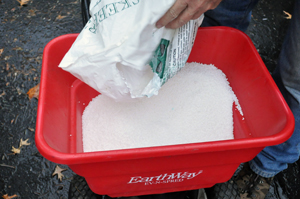November: Fertilize Kansas City Cool Season Lawns One Last Time Before Winter
Before calling it quits for the year on the lawn, there is one last important chore left to perform — fertilization. November fertilization is one of the most important yearly applications to a bluegrass or tall fescue lawn.
Use quick-release, high nitrogen lawn fertilizer
An application of a high, quick release nitrogen fertilizer will pay big dividends next spring. Examples of fertilizers to use at this time of year are 27-3-3 or 30-0-3. It should be applied at the rate of 1-pound actual nitrogen per 1,000 square feet. Application rates are listed on the bag, depending on the spreader type. The nitrogen applied will be taken up by the plants and converted to stored energy or food for the plant. The root system is the big winner with this application. Even though there is not a lot of top growth occurring in November, the warm soils promote root development and nutrient uptake.
Fertilize cool-season lawns in November to promote early spring green up
When spring rolls around the nutrients needed for early spring green up are already in place. The grass plant can simply use what it needs. The November application actually takes the place of an early spring application. Research has found that fertilizer applied in the spring is not converted to stored energy, but goes directly to top growth.
Simply stated, early spring fertilization results in increased mowing with little benefit to the roots. Remember, the roots are vital for good top growth; poor roots mean poor blade development.
When to apply last lawn fertilization
The final November fertilization is normally applied about the time of your last mowing. In the KC area, this can be anytime from mid-month through Thanksgiving. Be sure to read and follow all label instructions.
A couple of tips: Wash out your spreader before putting it away for the season. This will remove any corrosive particles that could damage the equipment. Don't forget to blow or sweep the fertilizer pellets off hard surfaces and back onto the lawn to prevent them from ending up in nearby streams and ponds. Do your part for clean water.
Other Resources
Do You Have Questions?
Have questions? The Garden Hotline is staffed by trained EMG volunteers and Extension staff who will assist you with questions.
Phone: (913) 715-7050
Email: garden.help@jocogov.org
Other Resources
Fertilizing Kansas Lawns
Have questions? The Garden Hotline is staffed by trained EMG volunteers and Extension staff who will assist you with questions.
Phone: (913) 715-7050
Email: garden.help@jocogov.org
